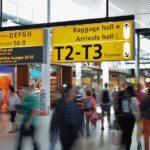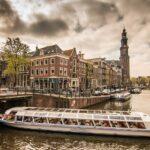There are 3 main transport authorities:
GVB operates buses, subways, ferries and streetcars. GVB is limited to transport within the city of Amsterdam, i.e. it does not provide transport to Schiphol airport, which is technically in another city.
There is also Connexxion, which operates intercity bus routes, some of which pass or stop in Amsterdam. Connexion has a bus that runs between Amsterdam and its airport.
And there is NS, the Dutch railway company. In general, you will only take the train if you are going to another city, but not necessarily. It is perfectly possible (and normal) to take a train to go between two stations in Amsterdam, as Amsterdam has several stations.
Common card
There is the Dutch public transport card, known here as the OV-Chipkaart.
Things are easy with the introduction of the unified public transport payment system, OV-Chipkaart (public transport smart card). Just enter and exit with the electronic card and that’s it. All public transport systems have either a turnstile or a machine near the boarding and alighting point. Find it and put your card there.
How to pay for public transportation in Amsterdam
But you can simply buy the I Amsterdam Card, which gives you unlimited transportation on Amsterdam’s municipal transport as long as your card is valid, plus free admission to 44 of Amsterdam’s museums, plus discounts.
Or you can buy the GVB ticket for the number of hours you will spend here in Amsterdam. There are 24, 48, 72, 96, 120, 144 and 168 hours. Again: the time starts from the moment you first check in! Always check in and out.
Is it worth it? It depends on how many transports you will take during the day. Calculate the one-time one-hour pass versus the one-day pass for your stay. See which is more economical, if you pay for the one-way tickets in one hour tickets or if it is more interesting to buy a card valid for the period you will stay.
You can buy the ticket in advance online, but remember that you have to collect the card from a GVB office. It’s easy, there is one right in front of the central station, at Schiphol (airport) and at several other stations in Amsterdam. Follow this link which shows all locations and times, see the prices and buy the card directly.
Note that these cards are from GVB, they do not work with other companies. This means that you cannot use this card to pay for transportation between the airport and Amsterdam.
How do I pay for a one-way ticket on public transport in Amsterdam?
If you did the calculation I suggested in the previous topic and concluded that it is more interesting for you to pay for a one-way ticket for public transport in Amsterdam, you should know that it is possible to buy a one-hour ticket (and that is enough for you to get everywhere in the city, using as many GVB transports as you want), but be careful because you cannot pay in cash in public transport.
It is important to know this. If you get on a streetcar and say “I want to pay for my ticket, here’s some money”, the driver or conductor will refuse you the money and tell you that you have to pay by card (they accept debit and credit cards).
Otherwise, walking is great exercise, and Amsterdam has no climbs, so convenient.
The streetcar has a collector/interchange, and you can buy your ticket with it or with the driver. Buses don’t have a collector, and you pay directly with the driver. The metro is a different story, you can buy from the machines (some accept cash, some don’t), or directly from the customer service at the station.
How to use the streetcar in Amsterdam
In Amsterdam, in the center, this is the best public transport. If you are visiting Amsterdam, it is likely that the streetcar will be your main means of transportation.
Using the tram is simple: wait at the bus stop. Most of the time you don’t need to signal, it is quite common for the streetcar to stop at all stops most of the time (unless the stop is empty and no one has asked to get off).
Enter through the first door, next to the driver, or through the double rear door, in front of the driver. The other doors are for exits (they are marked with a red circle with a white stripe inside, which means, do not enter).
There are preferential seats and an empty space next to the attendant. This space is reserved, in this order of preference: wheelchairs, strollers and bags. A person with a suitcase must yield to a stroller, a stroller must yield to a person in a wheelchair.
To get off, find a red stop button. When the streetcar stops, there is a green button next to the door. Press it and it opens. Check and get off.
How to take a bus in Amsterdam
In Amsterdam, the municipal lines are operated by GVB, and in the parts where the streetcar does not arrive, the bus dominates. In the center, the streetcar is the main line, although there are of course several bus lines.
Connexxion operates, in addition to some local lines, interurban lines, serving places that are out of reach of GVB.
You get on at the front, you hop on with your OV-Chipkaart, you sit down, you watch the stops announced on the monitor and by the loudspeaker system, you go to the exit, when you want to get off, you press the stop button.
How to take the metro in Amsterdam
The metro is not very useful for those who will only visit the city center. There are of course metro stations in the center, but they are so close to each other that it is usually not useful to use the metro between them.
If you go further, then the metro will be interesting. As a tourist, I’d say your best bet for taking the metro is to go to the Bijlmer ArenA, where there is a shopping area and the Ajax stadium, the Amsterdam ArenA (where in addition to matches and a tour for visitors, there are some concerts). The Ziggo Dome, where concerts are held, is also located in this metro station.
The interval between trains is longer than between trains and buses, for example, and can easily exceed 15 minutes, up to 20 minutes, which is very annoying for those who calculate the time to go somewhere and miss the train by a few seconds.





